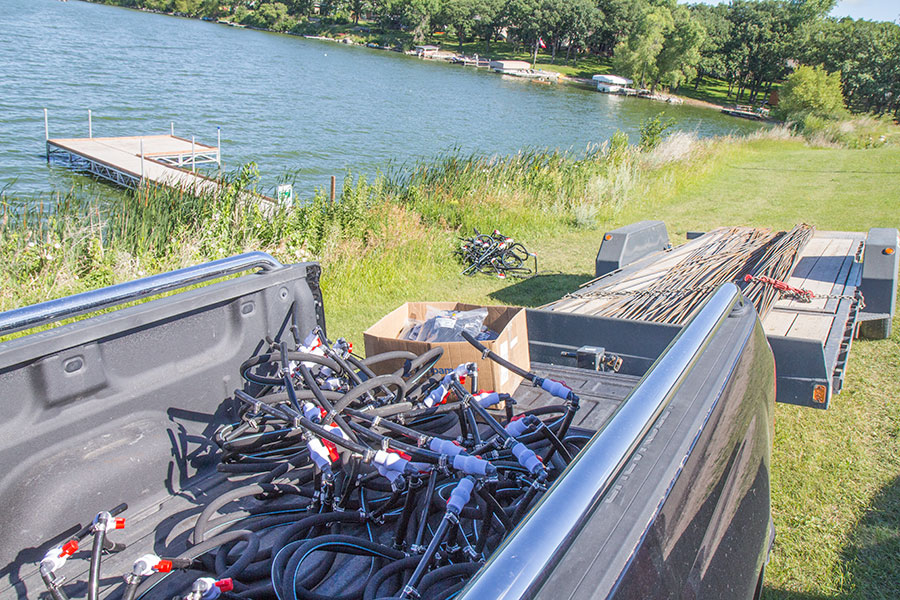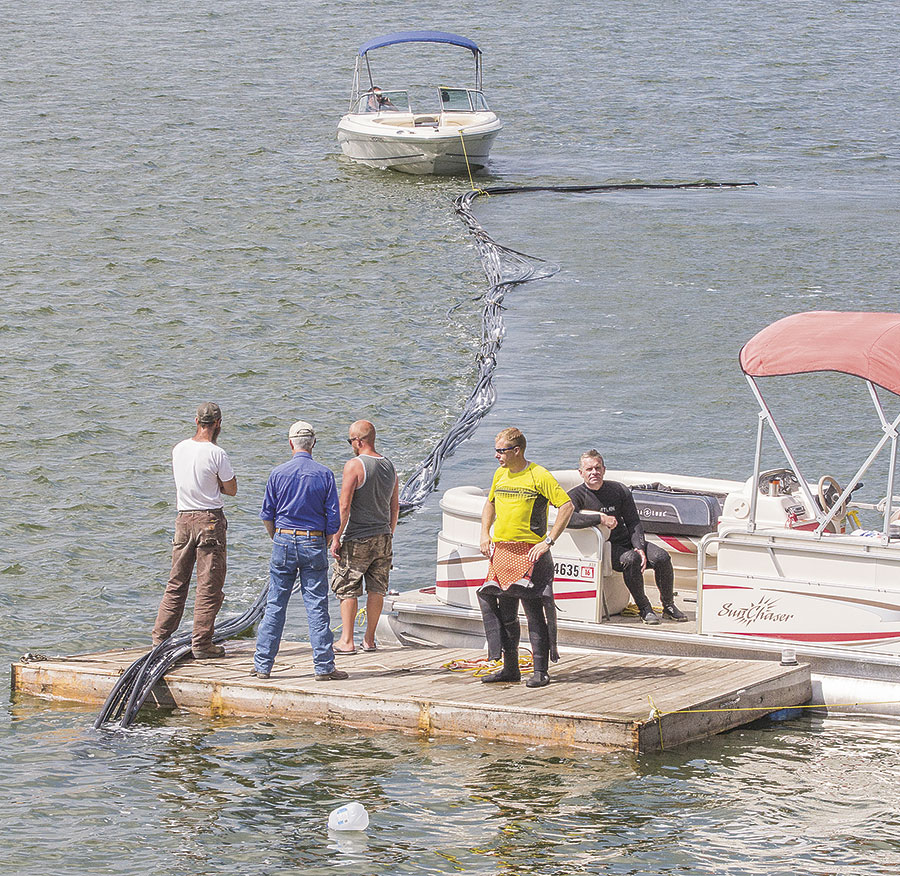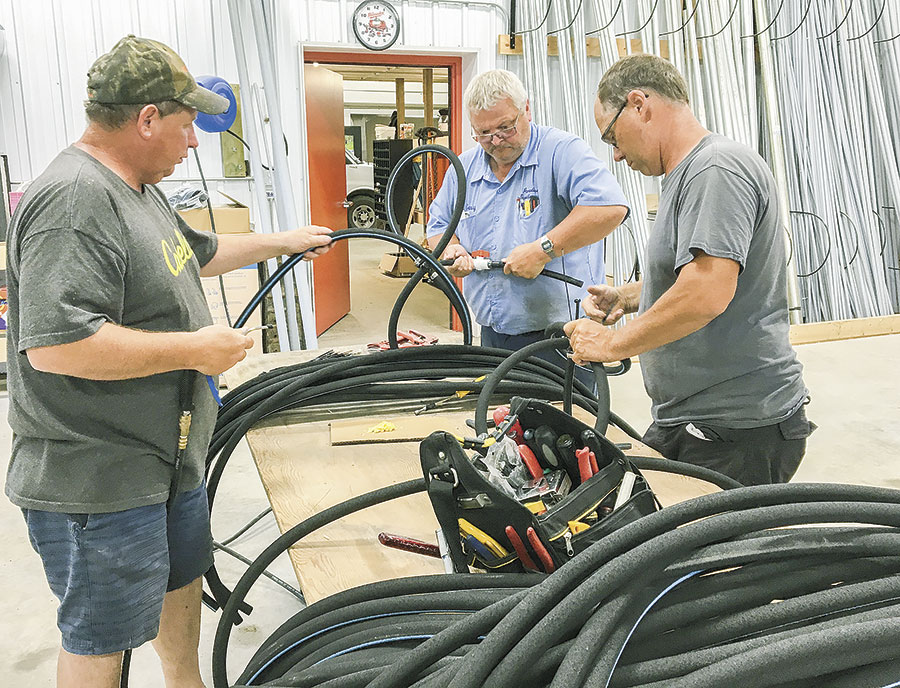
BY KIM LANGEN
It might well have been champagne bubbling up on Monday evening, as the new aeration system on the lake began percolating to the surface.
The Killarney Lake Aeration Project became operational at the end of the long summer’s day, to the surprise of a number of volunteers who were expecting a two-day operation.
Kelvin McMullen, one of the volunteers, was on the lakeside earlier that morning, armed with a trailer load of rebar and a pickup box of the bubbler heads.
“I will be using zip ties to attach the rebar to the aeration lines,” said McMullen. “Basically my tools today will be a few screwdrivers, and the ties. The pump house over by the water treatment plant is getting set up now, and the compressor should be running soon. We need some air pressure in the lines as we are working.”
Around 10 volunteers were on site at that time to help with the set up, he said.
“There will be six bubbler heads attached to each of the 10 lines,” said McMullen. “The rebar is 20 feet long, and there will be one of those on each line to weigh it down at the lake bottom. The 10 lines will run out like a fan from the hub near the water treatment plant, all the way here near the beach.”
Also on site that morning was a team from the University of Manitoba, headed by Joe Ackerman, a research assistant in bio systems engineering.
“We are here to do testing and recording of the water column and animals,” said Ackerman, who has been involved with the Killarney Lake Action Committee for a number of years. “We want to take readings before and after the bubbler system is installed. We are also looking at the benthic layer; we will be going out in a boat to collect our samples.”
By the end of the very long day – thanks to a perfectly calm lake surface – all 60 bubbler heads had been attached to the lines, and the job was completed.
That evening the water surface was gently moving, some 20 feet above the bubbler heads lying at the lake bottom.
And to the surprise of the volunteers, it even got the fish jumping in celebration.
“It could have been a coincidence, but we had fish jumping all over the place as we were putting bubbler heads down,” said co-chair of the project, Clarence Sawatzky. “And that evening, one of the residents who lives on the lake phoned me and asked me if it was the bubbler heads that were making the fish jump so much.”
One final job on the project is to send local scuba divers Sean Phillips and Brad Heide back down to the lake bottom to make sure all the bubbler heads are facing upwards for maximum benefit.
And there are also a few things for the public to know about the aeration system.
One is not to drop anchors over the system, or to trawl while fishing in the area of the aerators.
“If they hook onto a bubbler head, it could rip it off, or damage it,” said Sawatzky. “Then we would have to go back down and fix it again, or possibly replace it.”
The project was completed thanks to a partnership between KLAC and the Pelican Lake Healthy Lake Committee.
Some $80,000 was raised this past year through fundraising to finance the aeration project, and a great many people donated time, energy, finances, expertise, goods in kind, and materials to make it a reality, said the group.
“It was definitely a team effort,” said Sawatzky. “Now we’ll just have to give it time to do its thing. We know this will be a slow process to clean up our lake and have a healthy lake again.”
 BUSY BUBBLER DAY AT THE LAKE – Volunteers worked some 15 hours on Monday to weigh down the fan-shaped field of 10 aeration lines, and attach 60 bubbler heads to them. Compressed air was already moving through the lines as the team worked, and by evening bubbles were gently rising on the lake surface, and the fish were jumping.
BUSY BUBBLER DAY AT THE LAKE – Volunteers worked some 15 hours on Monday to weigh down the fan-shaped field of 10 aeration lines, and attach 60 bubbler heads to them. Compressed air was already moving through the lines as the team worked, and by evening bubbles were gently rising on the lake surface, and the fish were jumping.

 ALL ABOARD – Lakefront neighbours Bart Sutherland (driving) and Kelvin McMullen were two of some 10 volunteers who hopped aboard to help install 60 bubbler heads (seen below) on Monday.
ALL ABOARD – Lakefront neighbours Bart Sutherland (driving) and Kelvin McMullen were two of some 10 volunteers who hopped aboard to help install 60 bubbler heads (seen below) on Monday.

 PUMP HOUSE PREPARATION – Volunteers (from left) Dale Ganske, Gerry Paradis, and Trevor Maguire prepare the aeration pump house on Monday.
PUMP HOUSE PREPARATION – Volunteers (from left) Dale Ganske, Gerry Paradis, and Trevor Maguire prepare the aeration pump house on Monday.
 ABUNDANCE OF BUBBLY – Bubbles were seen on the surface of Killarney Lake earlier this week on a calm evening, after the Killarney Lake Aeration Project became fully operational on Monday.
ABUNDANCE OF BUBBLY – Bubbles were seen on the surface of Killarney Lake earlier this week on a calm evening, after the Killarney Lake Aeration Project became fully operational on Monday.
JAY STRUTH, KIM LANGEN, WENDY JOHNSTON/KILLARNEY GUIDE PHOTOS
 AERATION LINES ON THE MOVE – Killarney Lake Aeration Project volunteers (from left) Nick Shackel, Randy Hodge, and Andrew DeCock, along with divers Sean Phillips and Brad Heide, watch last month as 10 new aeration lines begin to be pulled into a reamed channel running under the lake bed. The lines were successfully received at the water plant end of their journey – and the task declared a success.
AERATION LINES ON THE MOVE – Killarney Lake Aeration Project volunteers (from left) Nick Shackel, Randy Hodge, and Andrew DeCock, along with divers Sean Phillips and Brad Heide, watch last month as 10 new aeration lines begin to be pulled into a reamed channel running under the lake bed. The lines were successfully received at the water plant end of their journey – and the task declared a success.
JAY STRUTH/KILLARNEY GUIDE
Lake lines in place for aeration project
BY KIM LANGEN
JUNE 29, 2018: After striking rubble trouble last week, a second attempt to lay the underground lake aeration lines this week resulted in triumphant success.
The team was back on site near the water treatment plant on Young Street on Monday morning, June 25, to try drilling and reaming a new line.
“The drill head has already gone out, around 220 feet out into the lake,” said Miguel Boulet, a Pugh’s Sand and Gravel employee, who was watching the progress on the water from the plant grounds. “We snagged on the bank last week. Today we are drilling a whole new hole, and we are using more mix to make it run easier and leave better walls.”
But windy weather made the lake surface choppy, and it took some time for the team out on the boats to determine just where the drill head had broken through below them.
On shore, the Pugh’s guys ran air through a compressor and down the line, in an effort to send bubbles up to the surface as a location pointer.
Eventually, scuba diver Brad Heide was able to descend and find the elusive drill head, some 20 murky feet below, tie a rope to it, and then bring the rope to the surface.
Then, three men on the boat above pulled long and hard on the rope to bring up the drill head, and to change it over to a new reamer.
“It’s very hard work to bring it up,” said Boulet. “It’s incredibly heavy. And this time we will run the reamer back and forth in the line a few times before we attach the aeration lines.”
On Tuesday, a reduced number of 10 aeration lines, made of geothermal piping, were attached to the reamer, which had been retrieved from the lake bottom by Heide and fellow diver Sean Phillips.
And then the nerve-wracking job of pulling the lines down from the lake surface, through the new channel, and back to the shore point, began.
“They were able to prep the hole, and have it in good shape,” said Clarence Sawatzky, member of the Killarney Lake Action Committee (KLAC), which is organizing the Lake Aeration Project. “And everything went well this morning. It was an easy pull.”
By Tuesday evening, volunteers had gathered together to create some 58 bubbler heads, which will eventually be attached to the 10 geothermal lines, laid out in a fan shape on the lake bottom.
The new compressor shed will soon be placed over the lines up by the water treatment plant, and eventually the compressor, plus the plumbing and the electrical components, will all be installed in the shed.
When it’s all completed sometime this summer, the compressor will force air down through the underground lines and out to the lake bottom.
Each of those lines will then send fresh air out through the multiple bubbler heads that will be attached to them.
Little bubbles will then percolate gently out of the bubbler heads, passing through the lake bottom detritus, and adding oxygen as they rise to the surface.
And then, the KLAC is hopeful Killarney Lake will slowly blossom and improve.
 FASHIONING 58 FIGURE EIGHTS – Killarney Lake aeration volunteers got together on Tuesday evening at the G&R Electric shop to cut and wind around 58 figure-eight-shaped bubbler heads. Made of a porous membrane, they will eventually be attached to the aeration lines in Killarney Lake at the end of July. From left are: Dale Ganske of G&R Electric, Gerry Paradis of Paradise Geothermal, and Clarence Sawatzky of the Killarney Lake Action Committee.
FASHIONING 58 FIGURE EIGHTS – Killarney Lake aeration volunteers got together on Tuesday evening at the G&R Electric shop to cut and wind around 58 figure-eight-shaped bubbler heads. Made of a porous membrane, they will eventually be attached to the aeration lines in Killarney Lake at the end of July. From left are: Dale Ganske of G&R Electric, Gerry Paradis of Paradise Geothermal, and Clarence Sawatzky of the Killarney Lake Action Committee.

